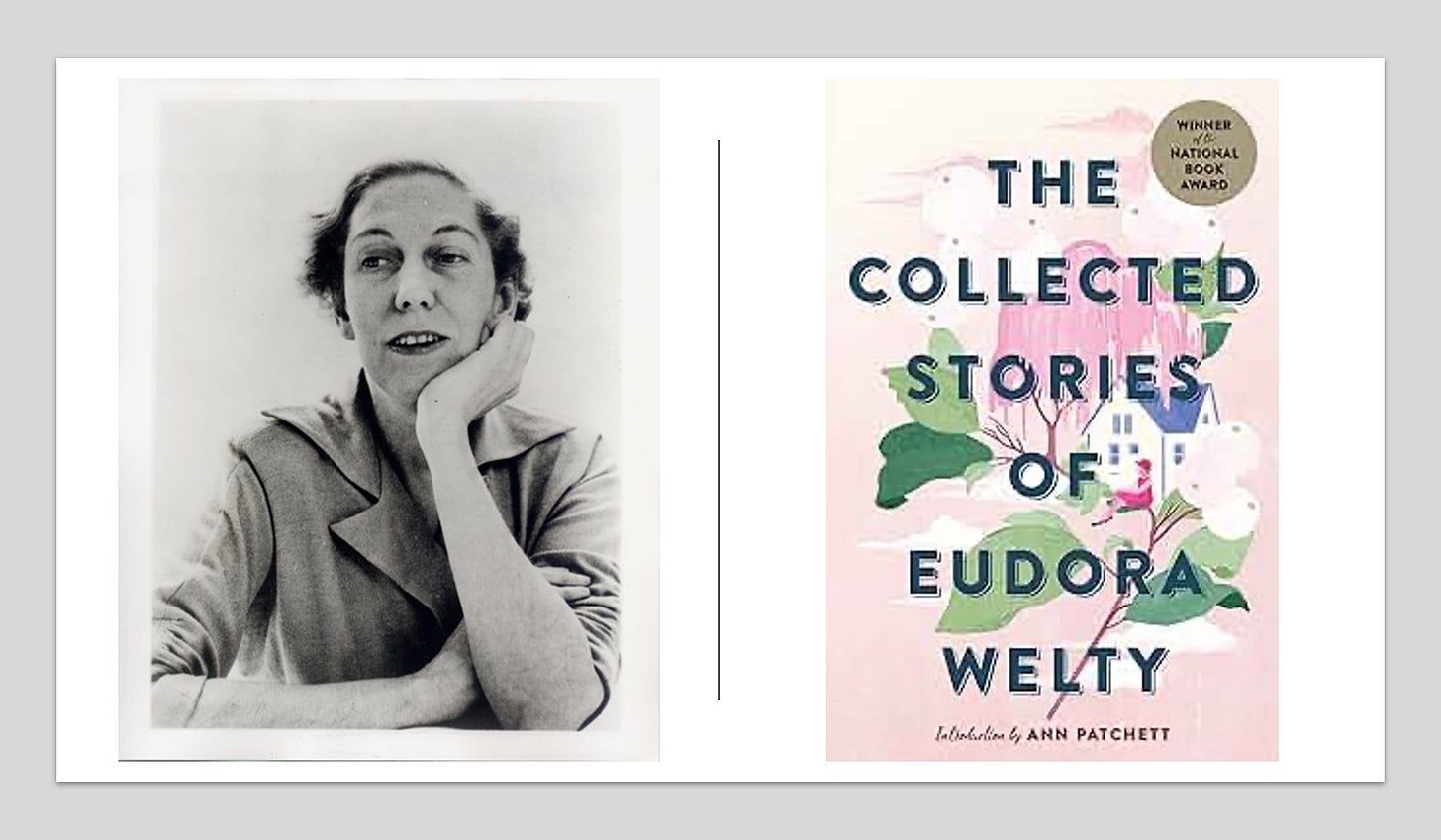Maybe I shouldn’t admit this as a Southern author, but I’ve never really gotten into Eudora Welty. I enjoyed her story “The Worn Path” in high school, and I’ve always appreciated her line, “One place understood helps us understand all places better.”
However, the place she understands and writes about has never done it for me. One possible explanation: In his review of William Gay’s first novel, The Long Home, Tony Earley wrote:
The fact is, most Southern writers live on one side or the other of a railroad track in the same small town. On one side of the track, half the population gathers after church in Miss Welty’s yard and listens to the other half cursing and breaking bottles in the neighborhood Cormac McCarthy lived in before he moved west.
I’ve traditionally been drawn to the guys (and it is mostly guys) on the rowdy side of the tracks—McCarthy, Gay, Larry Brown, Barry Hannah, Ron Rash, George Singleton—which means I’ve given Welty short shrift.
This year I picked up The Granta Book of the American Short Story (vol. 2), edited by Mississippi native (and at one time a neighbor of Welty), Richard Ford. Opening the anthology is Welty’s story “Ladies in Spring,” which I suppose exists on the polite side of the railroad track but also strikes me as the paragon of what we mean when we talk about “Southern Literature.”
Quick Summary of “Ladies in Spring”
The story, originally published in the Sewanee Review in 1954, is about an elementary school-aged boy named Dewey. At school one morning, he sees his father walking with a pair of fishing rods, so he ducks out to join his father for the day.
On the way to the fishing spot, they see a woman named “Miss Hattie,” a rainmaker who is zigzagging down the trail to her own spot to do whatever she is going to do to make it rain. Dewey and his father continue to a bridge, where they spend the day not catching much. While they’re there, another woman comes out of the woods and appears to be calling for Dewey’s father—who ignores her.
In the early afternoon, the sky opens up, and it starts to pour. They run along and catch up with Miss Hattie, who offers them shelter under her big umbrella as they walk back to town. Another woman, Hattie’s niece Opal Purcell, who had been gathering plants from the woods, joins them, shunting Dewey into the rain. They parade through town, where people offer commentary about the weather from their porches until they reach the spot where Dewey’s father and Opal part ways.
Since Dewey’s all wet, Miss Hattie takes him to her job at the post office rather than sending him back to school. He watches the comings and goings there for a while, and then returns to school in time to catch the bus home. There, he bickers mildly with his mother, who says she’s had enough of him and his father.
A few days later, he returns to the fishing spot by the bridge and spies a stray dog by a church, and the dog’s visage reminds him of Hattie standing in the post office and staring off into the rain.
What’s this story all about?
The summary above sounds a little flat to me. When you strip away Welty’s language, the events of the story become somewhat unremarkable. What’s the point? Why is this story so affecting? (And it is affecting, even if the summary doesn’t sell you on it.)
One thing to note is that although Welty has third-person narration, the story is retrospective—meaning, it takes place at least fifteen years before it was written. We know this because of a small flash-forward toward the end, where Dewey is running through the rain toward the school bus:
As Dewey began to run, he caught a glimpse of a patchwork quilt going like a camel through the yard next door toward Miss Hattie’s house. He supposed Opal was under it. Fifteen years later, it occurred to him it had very likely been Opal in the woods [the woman who called out to his father].
What we have, then, is an ordinary day that made an impression in Dewey’s consciousness, so that fifteen years later he’s still analyzing it. Memory works like this: We don’t remember every single day, and the memories we retain are a curious blend of the significant and the banal.
Why this day, then? For Dewey, it is out of the ordinary—the day he skipped school to go fishing—but it’s also the day he starts to learn something about the secret inner life of his father.
Who was the woman calling his father from the woods? Why? And why did he ignore her? When Opal shows up under her aunt’s umbrella, there’s a hint of tension: “She was grown. Sometimes she waited on people in the Seed & Feed. She was plump as ever. She didn’t look far enough around her aunt to speak to his father.”
Dewey doesn’t know what’s going on there—even fifteen years into the future—so neither do we. Maybe it’s something dramatic like an affair, or maybe it’s nothing. What matters is that other people are a mystery, and on this day Dewey experiences mystery and wonder that follow him into adulthood.
At the end of the story, when he returns to the fishing spot, he finds it unrecognizable. The rain has filled the river: “It covered the sandbars and from the bridge he could no longer remember exactly how the driftwood had lain—only its upper horns stuck out of the water, where parades of brown bubbles were passing down.”
Like the driftwood, the day in question—“a soft, gray, changeable day”—has shifted from objective reality into subjective memory. Dewey can have an epiphany about it later (oh, of course that was Opal in the woods, duh) but his only real tool for understanding is the memory of what he observed. Such is life.
Southern language on display
I called this a “paragon of Southern Literature” above and mentioned Welty’s language as the thing that makes the story. This story describes a small town in Mississippi, presumably in the 1940s, a time and place that encapsulates the “New South,” a historical moment that, like Dewey’s memory of the day, no longer exists.
To start, it’s a world where the education system is lax enough that a kid could run off and return in time to catch the bus home without creating a fuss. The family lives on a farm and has the leisure to go fishing in the middle of a weekday. When they parade into town, the townspeople are all sitting on porches watching it rain. And stray pigs are wandering by the bank.
This milieu existed only for a short time—when small towns had cars and electricity, but the modern world hadn’t come in to take over with mass electronic communications and government regulations. And it’s a world we’re nostalgic for today, with Facebook slop along the lines of, “Back in my day, we drank out of garden hoses, caught lightning bugs, and stayed out until the street lights came on!”
Welty’s details give us the time, but her language gives us the place. We get “brambles,” “poke salad,” a “gully” and a “gully washer.” The voice of the narrator says, “They didn’t catch anything, sure enough.” Dewey’s father says, “It’s fixing to pour down!”
We have corrugated tin roofs and a patchwork quilt and all manner of flora and fauna: a blown-over sycamore, baby turtles, hanging moss, cows and calves, pigs with “snouts as long as corncobs,” snap beans, pear trees, “maples red as cinnamon drops,” “gold soldier-tassels of distant oaks,” and on and on.
Then there are the names: Miss Pruitt, Miss Hattie, Opal, Blackie, Dewey Coker, and his sisters Minnie Lee, Sue, and Annie Bess. These names transport you into the rural South of yesteryear. Maybe not Mississippi explicitly, but you can’t picture this collection of names in a story by one of Welty’s Yankee contemporaries. Cheever, say.
Final thoughts (for now)
Listen to this first sentence from Welty’s short story “Why I Live at the P.O.”: “I was getting along fine with Mama, Papa-Daddy and Uncle Rondo until my sister Stella-Rodo just separated from her husband and came back home again.”
Or this opening to “A Petrified Man”: “ ‘Reach in my purse and git me a cigarette without no powder in it if you kin, Mrs. Fletcher, honey,’ said Leota to her ten o’clock shampoo-and-set customer. ‘I don’t like no perfumed cigarettes.’ ”
Nobody could write those sentences today without it sounding like an affectation—writing about the South rather than writing the South as it is (assuming “The South” even exists anymore, which I don’t think it does).
Welty couldn’t have known in the 1950s how the world was going to flatten, but she captured this brief time and place as if in amber. Reading “Ladies in Spring” in middle age, I suspect I might have been persuaded toward her side of the railroad track.
More from Jon Sealy:
To read more of my thoughts on literature, consider buying a copy of my craft memoir, So You Want to Be a Novelist. If you are an author trying to figure out what to do with a manuscript, I also offer a limited number of consulting engagements every year. Learn more here.







